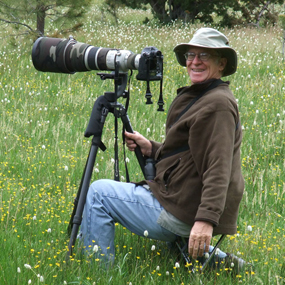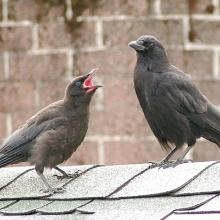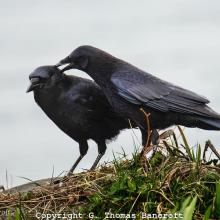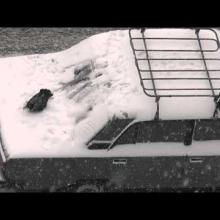

Join BirdNote tomorrow, November 30th!
Illustrator David Sibley and actor H. Jon Benjamin will face off in the bird illustration battle of the century during BirdNote's Year-end Celebration and Auction!
Is that big black bird a crow or a raven? How can you tell? Ravens (seen right here) often travel in pairs, while crows (left) are seen in larger groups. Also, study the tail as the bird flies overhead. A crow's tail is shaped like a fan, while the raven's tail appears wedge-shaped or triangular. Another clue is to listen closely to the birds' calls. Crows give a cawing sound, but ravens produce a lower croaking sound.
Learn a lot more about these birds in this blog post.
BirdNote®
Ravens and Crows – Who’s Who?
Adapted by Dominic Black from a piece by Frances Wood and Dennis Paulson
This is BirdNote.
[Suburban street ambient and Northwestern Crow sound]
So, you’re walking down the street, and a trash can’s been tipped over. And eagerly picking through the riches strewn across the sidewalk are several black birds. They’re crows. Or…ravens. No, definitely crows…maybe?
How can you tell the difference? Well, first off: listen. Crows caw:
[Northwestern Crow’s caw, caw]
While ravens croak:
[Raven’s croak]
And while Common Ravens and American Crows look quite similar, there are a few ways to tell them apart:
Ravens are larger. And they often travel in pairs. Crows usually hang out in larger groups.
Next, try to get a look at the bird’s tail.
A crow’s tail feathers are basically all the same length, so its tail opens like a fan. But a raven has longer middle feathers in its tail, so it looks more like a wedge or a triangle.
By far, though, the best way to tell these two birds apart is to look at their bills. The crow has a modest bill, but the raven has a great big chunky-looking beak that pretty much says "Yeah, that’s right. I’m a raven."
Ravens tend to stick to the wilder parts of the world, like woodlands and open spaces. But when you’re walking past those trash cans, you’re probably seeing crows.
[crows]
For BirdNote, I’m Michael Stein.
###
Producer: John Kessler
Managing Producer: Jason Saul
Editor: Ashley Ahearn
Associate Producer: Ellen Blackstone
Assistant Producer: Mark Bramhill
Narrator: Michael Stein
Special thanks to Dominic Black, Dennis Paulson and Frances Wood.
Bird sounds provided by The Macaulay Library at the Cornell Lab of Ornithology, Ithaca, New York. Recorded by G. A. Keller and G. Vyn. Ambient recorded by C. Peterson.
BirdNote’s theme music was composed and played by Nancy Rumbel and John Kessler.
© 2019 BirdNote September 2018 / 2019 / October 2022
ID# 091605corvid AMCRCORA-01b-2010-09-28 AMCR-CORA-01d










